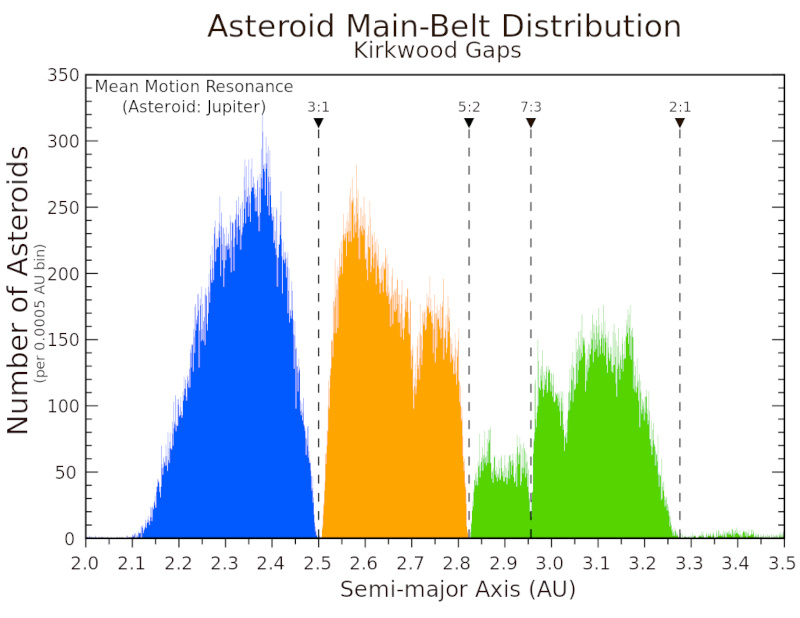
Image: This histogram clearly shows Kirkwood's major gaps in the main asteroid belt. The gaps (labeled “3:1”, “5:2”, “7:3”, “2:1”) are caused by mean motion resonances between an asteroid and Jupiter.
JPL NASA (Public domain).
Although the means of observation were limited compared to today, the American astronomer Daniel Kirkwood (1814-1895) identified in 1866 the famous gaps in the distribution of asteroids in the main belt. These gaps today bear his name.
Kirkwood calculated the distances from the Sun where orbital resonances with Jupiter were strongest. He found that these distances corresponded to empty areas in the distribution of asteroids.
Daniel Kirkwood's work on Kirkwood's deficiencies lasted approximately ten years. He began working on this subject in 1866 and published his results in 1877.
Today, thanks to telescopes (Hubble, Gaia, TESS, Pan-STARRS, LSST and Catalina Sky Survey) capable of scanning large regions of the sky in a single night, astronomers can detect large numbers of asteroids and calculate their distances.
Thus, the Kirkwood gaps are areas empty of asteroids, located at specific distances from the Sun.
The physical explanation for these gaps lies in the phenomenon of orbital resonance.
One of the most well-known resonances is the 3:1 resonance, where an asteroid orbits the Sun three times while Jupiter completes a single orbit.
In other words, the gravitational influence of the giant planet disrupts the asteroids' orbits. These disturbances result in distinct gaps in the distribution of asteroids.
As a result, asteroids resonant with Jupiter have specific orbital periods that highlight gaps in certain regions of space.
When an asteroid resonates with Jupiter, repeated gravitational interactions with the planet cause selective disturbances in its orbit. This can lead to specific positions in orbital space where the asteroid's energy is unstable, possibly leading to collisions with other celestial bodies or ejections from the asteroid belt. These events prevent asteroids from remaining in these disturbed areas for very long.
The precision with which the Kirkwood 3:1 gap is known depends on the method used to measure it.
If we base ourselves on the distribution of the semi-major axes of the asteroids, we can estimate the position and width of the gap with a precision of the order of 0.01 AU, or approximately 1.5 million kilometers.
If we base ourselves on orbital and secular resonances, we can refine the precision to the order of 0.001 AU, or approximately 150,000 kilometers. These values are approximate, however, because asteroid orbits are subject to long-term chaotic variations.
In addition to the main gaps, there are many other smaller gaps in the main asteroid belt. These gaps are caused by orbital resonances with Mars and Saturn.